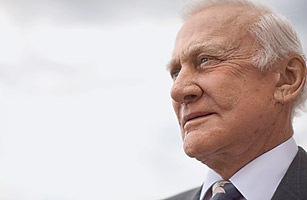
(2 of 4)
The Rightest Stuff
In many ways, the men chosen to go to the moon were uniquely equipped to deal with such complex emotional questions — if only because they weren't wired to give them much thought. Jack Swigert, whose sole trip into space was aboard the aborted Apollo 13, once observed that the odd banality of the air-to-ground communications from the Apollo missions, in which astronauts getting their first glimpse of the moon rarely uttered anything more poetic than "amazing" or "fantastic," was no accident. The very things that qualified the men to go to the moon, he believed, disqualified them to describe their journey with any lyricism. Think too deeply about what you're doing and the enormity of the thing can stop you from getting it done. And when one crewman violated that unwritten code of sangfroid, others, often as not, would stop him cold.
"Hey, let me ask you this," Apollo 10's Gene Cernan can be heard saying to his crewmates on a once classified closed-loop recording as the three men peered out the window at the moon below them. "Where do you suppose a planet like this comes from? Do you suppose it broke away from the Earth like a lot of people say?"
"I ain't no cosmologist," astronaut John Young answers with deliberate bluntness. "I don't care nothing about that."
NASA officials carefully screened for pilots who were made of tough physical stuff, and they chose well. In 1930, about the time most of the lunar astronauts were born, the life expectancy for a white American male was 59.1 years. In 2009, three-quarters of the former moonmen are still alive, and all of them are near or past 80 — not a likely result of chance. The doctors weren't looking equally hard for men who were free of poetry or fancy, but it was no surprise that they got that too. "They were all fighter pilots," says Dr. J.D. Polk, NASA's current chief of medical operations. "Psychologically speaking, they were a pretty self-selecting group."
But if the pilots weren't wired for wonder, they were wired for fun. After the successful mission of Apollo 11 — a serious, almost grimly flown affair — things loosened up, and the astronauts took advantage of the high adventure of their jobs. When the late Pete Conrad, commander of Apollo 12, hopped down from his lunar module, he eschewed any resonant words about small steps and giant leaps and went instead for a simple "whoopee!" Years later, I asked him if he had found it hard to enjoy himself on the surface, knowing that if the lunar-module engine didn't relight, he was never going home again.
"Nah," he said. "I was a happy guy on the moon." He got over his fear the first time he orbited Earth, when a failed retro-rocket would leave him just as stranded — and just as dead — as if he were stuck on the moon.
Conrad wasn't alone in enjoying his lunar mission. Most of the flights after Apollo 11 run together in the public mind, but all are recalled as a procession of bunny-hopping, buggy-driving American men, frequently joking, sometimes singing and generally having a grand time. "Man, this is a fun ride!" Duke exclaimed as he drove about the terrain in his collapsible moon car. Ken Mattingly, Duke's Apollo 16 crewmate, was reluctant even to look out the window of the orbiter too much, for fear that the next transcendent view would wipe out the previous one. "My mind was an erasable memory," he says. "It just deleted the last experience."
Even Apollo 14's Alan Shepard, known as the "ice commander" for the severe approach he sometimes took to his work, melted with delight at what he was doing. "You're ready to go out and play in the snow," he said to Edgar Mitchell as he helped the rookie astronaut climb into his suit before they left the lunar module.
Hard Landing
The fun ended fast, however. The longest of the lunar missions lasted just 12 days; the shortest, about a week. When the first three flights that landed on the moon — Apollo 11, 12 and 14 — came home, the astronauts were swaddled in biocontainment suits and hustled into quarantine, where they spent three weeks under observation in case they had picked up any lunar pathogens. The first good look the world got of Apollo 11's Aldrin, Neil Armstrong and Michael Collins after their return was thus through the window of a trailer on the deck of the recovery ship U.S.S. Hornet, where they waved to President Richard Nixon and the crowd outside — a tableau Aldrin describes as a "circus spectacle." Later they were transferred to roomier quarters in Houston. Most people reckoned that the astronauts loathed the indignity of the nickel-a-peek display and the 21-day lockup, but the truth was that they rather needed it.